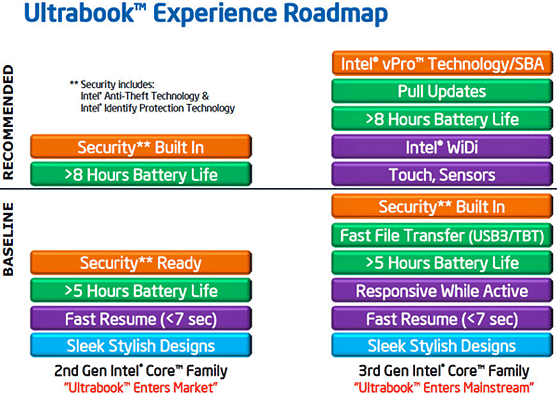Intel Core i5-3427U: Ivy Bridge For Ultrabooks
Intel's Ultrabook, Current Vision and Roadmap
An "Ultrabook" as envisioned by Intel, is more about design aesthetics and user experience than it is about the underlying technology. As much as it may pain some of you to read this, Intel has essentially taken a page from the book of Apple with the Ultrabook as we know it today, such that the technology roadmap, something that not all mainstream consumers can relate to, has taken a back burner to the "Experience Roadmap." This is not a bad thing of course. After all, technology will always be the driving force and enabler of the experience; it's just a different way of looking at product solutions versus speeds, feeds and capacity.
Below is what Intel has set forth for its OEM and ODM partners with respect to what they're looking for in the Ultrabook experience for both minimum and optimal product features.

Intel sets forth requirements for not only battery life but also system responsiveness, both active and resume from sleep, security features like Identity Protection and Anti-Theft Technologies, USB 3.0 connectivity and even touch sensors in 3rd Gen Intel Core Family-based Ultrabook designs. Taking cues from the slide above, you can also see that Intel envisions Ultrabooks comprising a significantly larger portion of their market share moving forward as well, with the Ultrabook moving to a "mainstream" product class in associated volume. Does this mean we'll see prices commensurate with mainstream adoption?
In fact it does. Intel has already announced that at least 75 new Ivy Bridge Ultrabook designs are coming with price points that should reach the $699 range. In addition, some of these designs will include touchscreens for Windows 8 hybrid tablet/notebook products like Lenovo's IdeaPad Yoga.






Below is what Intel has set forth for its OEM and ODM partners with respect to what they're looking for in the Ultrabook experience for both minimum and optimal product features.

In fact it does. Intel has already announced that at least 75 new Ivy Bridge Ultrabook designs are coming with price points that should reach the $699 range. In addition, some of these designs will include touchscreens for Windows 8 hybrid tablet/notebook products like Lenovo's IdeaPad Yoga.

In terms of system responsiveness, Intel-based Ultrabooks will make use of Intel RST (Rapid Start), SRT (Smart Response) and SC (Smart Connect) technologies, to enable a generally snappier experience. We've seen all of these technologies in one form or another in the Sandy Bridge architecture as well. Regardless, Intel's cache-driven wake from hibernate technology (RST) along with Smart Connect, (which briefly powers up the system to pull feeds and updates from sites and services you might have running like Twitter, Facebook or RSS feeds) is impressive to see in action and definitely adds to the overall quality of experience as does the system responsiveness when combined with SSD caching of the hard disk with SRT.





Other than the fact that this is a really thin and sleek 13.3" notebook, there's not a lot that calls your attention to the fact that it's a 3rd generation Core i5 Ivy Bridge-based machine. What you're looking at here will not be sold as a retail product but rather is just an ODM whitebook setup to demonstrate Intel's new low power Ivy Bridge mobile processor technology. The design is really quite nice, however, with a rubberized flat black top and bottom shell, along with a composite silver finish keyboard and palm rest area.
One of the highlight features of this machine, beyond it's power-efficient performance that we'll show you next, is its high resolution 1600x900 LED backlit display. We're hoping manufacturers take Intel's cue here and follow suit accordingly for 13 and 14-inch machines. Finally, with a 240GB Intel Series 520 SSD under the hood, coupled with 8GB of DDR3-1600 system memory, the Core i5-3427U Ivy Bridge Ultra chip at its helm is setup nicely for high performance.
One of the highlight features of this machine, beyond it's power-efficient performance that we'll show you next, is its high resolution 1600x900 LED backlit display. We're hoping manufacturers take Intel's cue here and follow suit accordingly for 13 and 14-inch machines. Finally, with a 240GB Intel Series 520 SSD under the hood, coupled with 8GB of DDR3-1600 system memory, the Core i5-3427U Ivy Bridge Ultra chip at its helm is setup nicely for high performance.







